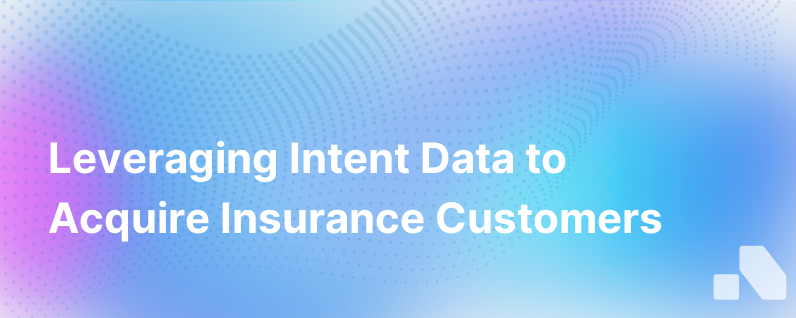
In the increasingly competitive world of insurance, identifying prospective customers who are in the market for insurance before they've made a purchasing decision is like finding the proverbial needle in the haystack. Intent data is the high-powered magnet that can make this difficult task a lot easier.
For insurance companies looking for an edge, intent data offers a transformative approach to identifying and targeting potential customers. By analyzing online behavior and signals, this data can indicate when a person or a business might be ready to purchase insurance, thereby allowing companies to engage with prospects proactively and precisely when they are most receptive to the message.
Understanding Intent Data
Intent data refers to the collection of behavioral signals that suggest a potential buyer is in market to purchase a product or service. For insurance companies, this includes tracking digital footprints such as search queries, web content consumption, and interactions with different websites. After all, today's insurance buyers—both individuals and businesses—frequently turn to the internet to research different policies, compare rates, and seek advice before speaking to an agent.
There are two main types of intent data:
- First-party intent data: This is the information you gather yourself from your own website, social media, or CRM system. It tells you how prospects interact with your content, which pages they visit, and how often they return. It's essentially the digital body language conveying a lead's interest.
- Third-party intent data: This information is collected by data providers who track and analyze activity across many websites or platforms, giving you insights into broader industry trends and specific companies or individuals' behaviors.
Combining these two types of data can offer a robust picture of potential customers' insurance interests and how close they might be to a purchase decision.
The Value of Intent Data for Insurance Companies
Leveraging intent data can drive several key advantages for insurance firms:
1. Improved Lead Quality
Intent data filters the broader market for prospects exhibiting real signs of interest in insurance products. Through intent signals, insurance companies can reduce the delta between themselves and genuinely interested leads, bypassing the need to engage in a numbers game with cold calling and generic marketing.
2. Enhanced Personalization
Knowing a prospect's specific interests allows insurance companies to tailor their communications and content. When a potential customer exhibits an interest in a particular insurance product, companies can personalize their outreach with relevant information, thus improving engagement and conversion rates.
3. Efficient Resource Allocation
Instead of spreading efforts thin across an array of lead-generation activities, intent data allows for targeted engagement, focusing resources on hot leads. This not only improves ROI but also ensures sales teams are speaking with prospects who are ready to listen.
4. Competitive Insights
Third-party intent data can reveal industry trends and signal when prospects might be considering competitors. With this information, insurance companies can position themselves strategically, intercepting buyers before they choose a competitor.
5. Predictive Analytics
Intent data can feed predictive models, helping to anticipate when leads are in the market. This foresight can give insurance companies a head start in nurturing leads to conversion.
Implementing Intent Data Strategies
Using intent data to find new customers involves several steps:
Step 1: Data Collection and Integration
Start by identifying data providers or tools that can help you aggregate first- and third-party intent data. This needs to be integrated with your CRM or marketing automation tools to effectively leverage insights.
Step 2: Identifying Intent Signals
Determine the online behaviors that signify a buying intent in the insurance space. It might be a surge in visits to your life insurance product page or an increase in white paper downloads about small business liability coverage.
Step 3: Scoring and Segmenting Leads
Develop a lead scoring system that integrates intent data points. Use this to segment leads based on intent signals—like warm leads who have been searching for term life insurance quotes or businesses exploring employee health benefits.
Step 4: Tailored Outreach
Craft marketing and sales approaches that specifically address the identified needs and behaviours of your segmented audiences. A prospect who's downloaded a guide on health insurance for small businesses, for example, will require different messaging than someone investigating auto insurance options.
Step 5: Real-Time Engagement
Utilize real-time alerts for when a prospect's intent signals indicate they are in a crucial decision-making moment, allowing for prompt and relevant engagement.
Step 6: Continuous Optimization
Like all good strategies, using intent data is an iterative process. Continually analyze the performance of your intent data-driven campaigns and refine your approach based on the results you see.
Measuring Success and ROI
To demonstrate the value of using intent data, insurance companies should measure key performance indicators like:
- Conversion rates from intent-qualified leads to paying customers
- Average deal size or policy value of intent-driven new business
- Cost per acquisition in intent data-targeted campaigns compared to broader efforts
- Engagement metrics (e.g. email open rates, time spent on page) in personalized outreach based on intent data
In conclusion, intent data equips insurance companies with the power to identify, understand, and effectively engage potential customers actively seeking insurance solutions. By adopting a data-driven strategy, insurance firms can reach their target market more efficiently, personalizing offers, enhancing lead quality, and ultimately driving growth in an ever-competitive market.
As businesses increasingly depend on digital ecosystems to conduct their research and make key decisions, insurers adapting to utilize intent data are positioning themselves to meet potential customers exactly where they are—one step ahead of the game.